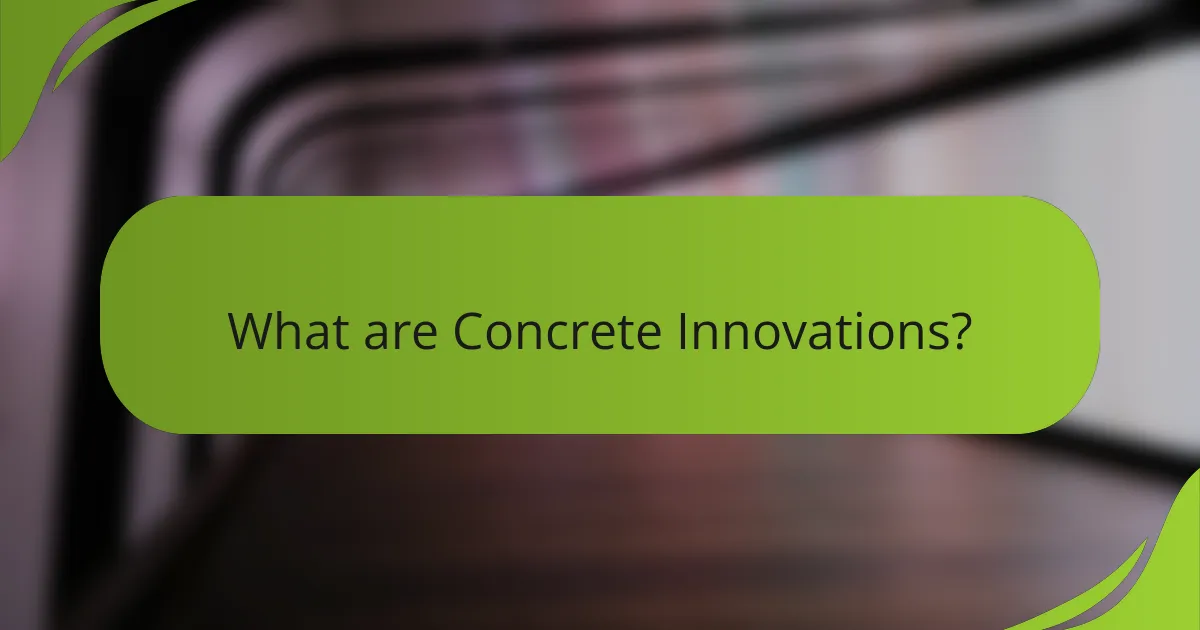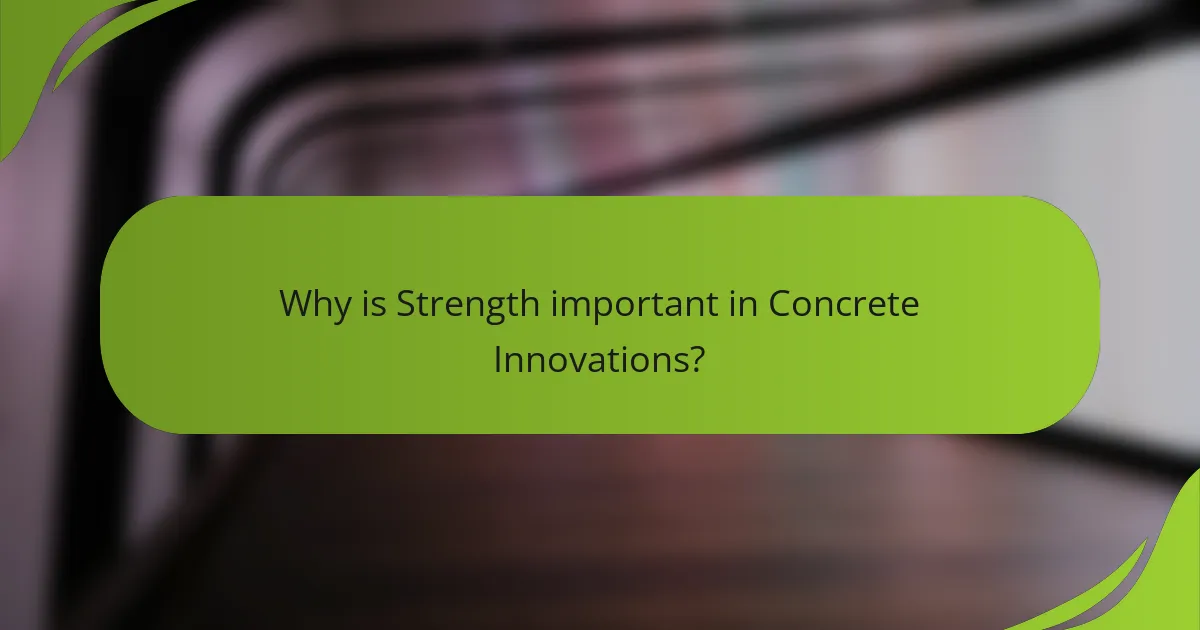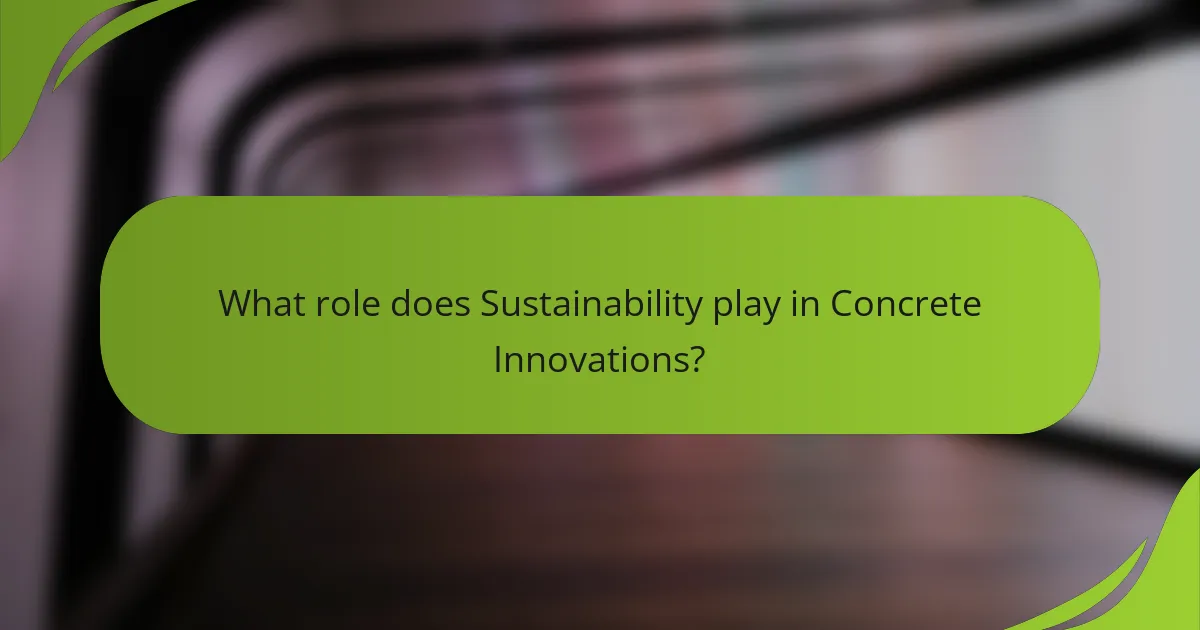Concrete innovations encompass advancements in the formulation, application, and technology of concrete, significantly enhancing its strength, durability, and sustainability. Key innovations include self-healing concrete that repairs itself, high-performance concrete with compressive strengths exceeding 10,000 psi, and the integration of recycled materials to reduce environmental impact. These developments not only improve the structural integrity and lifespan of concrete but also promote eco-friendly construction practices by lowering carbon emissions. Additionally, aesthetic enhancements in concrete, such as polished finishes and decorative overlays, cater to the demand for visually appealing structures, further driving the evolution of concrete technology.

What are Concrete Innovations?
Concrete innovations refer to advancements in the formulation, application, and technology of concrete. These innovations enhance the material’s strength, durability, and sustainability. For instance, self-healing concrete can automatically repair cracks, extending its lifespan. Additionally, the use of recycled materials in concrete mixes reduces environmental impact. Innovations like high-performance concrete improve load-bearing capabilities significantly. Furthermore, developments in 3D printing with concrete allow for complex architectural designs. Research indicates that these innovations can reduce carbon emissions associated with concrete production. Overall, concrete innovations contribute to more efficient and eco-friendly construction practices.
How have Concrete Innovations evolved over time?
Concrete innovations have evolved significantly over time. Initially, concrete was a simple mixture of lime, water, and aggregates. The invention of Portland cement in the 19th century revolutionized its strength and durability. In the 20th century, the introduction of reinforced concrete allowed for more complex structures. Advances in technology led to the development of high-performance concrete, enhancing its load-bearing capacity. The 21st century has seen a focus on sustainability, with innovations like recycled aggregates and eco-friendly admixtures. Smart concrete technologies, which incorporate sensors, are now being explored for real-time monitoring. These advancements reflect a continuous drive for improved performance and environmental responsibility in concrete applications.
What historical advancements have influenced Concrete Innovations?
The historical advancements that have influenced concrete innovations include the development of Portland cement in the 19th century. This cement formulation improved strength and durability compared to earlier binding materials. The introduction of reinforced concrete in the late 1800s allowed structures to bear greater loads. Innovations such as high-performance concrete emerged in the 20th century, enhancing durability and sustainability. The use of admixtures has also evolved, allowing for better workability and performance. Advances in technology have led to the incorporation of recycled materials in concrete mixes. These advancements have collectively transformed concrete into a versatile and sustainable building material.
What recent developments are shaping the future of Concrete Innovations?
Recent developments shaping the future of concrete innovations include advancements in sustainable materials and smart concrete technology. Sustainable concrete incorporates recycled materials, reducing carbon footprints. Innovations like carbon capture and utilization are enhancing concrete’s eco-friendliness. Smart concrete integrates sensors for real-time monitoring, improving structural health management. Additionally, 3D printing technology is enabling the creation of complex designs and reducing waste. Research indicates that these developments can significantly enhance the durability and efficiency of concrete structures. The adoption of these technologies is expected to transform construction practices and promote sustainability in the industry.
What are the key attributes of Concrete Innovations?
The key attributes of Concrete Innovations are strength, sustainability, and aesthetic appeal. Strength refers to the enhanced durability and load-bearing capacity of innovative concrete mixtures. Sustainability includes the use of eco-friendly materials and practices that reduce environmental impact. Aesthetic appeal relates to the versatility in design and finishes that modern concrete can achieve. These attributes collectively improve performance and visual quality in construction projects.
How does strength play a role in Concrete Innovations?
Strength is a critical factor in concrete innovations. It determines the load-bearing capacity of concrete structures. Innovations such as high-performance concrete enhance strength significantly. These materials can withstand higher stresses compared to traditional concrete. For example, fiber-reinforced concrete increases tensile strength. This results in improved durability and reduced cracking. Additionally, advancements in mix design optimize the strength-to-weight ratio. This allows for lighter structures without compromising safety. Overall, strength innovations lead to safer, more efficient construction practices.
What sustainability practices are integrated into Concrete Innovations?
Concrete Innovations integrates several sustainability practices. These practices include the use of recycled materials in concrete production. They also implement energy-efficient manufacturing processes. Water conservation techniques are employed throughout their operations. Additionally, they focus on reducing carbon emissions during production. The company prioritizes sustainable sourcing of raw materials. Their products are designed for durability and longevity, minimizing waste. Lastly, Concrete Innovations engages in community initiatives promoting environmental stewardship.
How does aesthetic appeal enhance the value of Concrete Innovations?
Aesthetic appeal enhances the value of Concrete Innovations by improving visual attractiveness and increasing market demand. Concrete Innovations with appealing designs attract customers and elevate project value. Research indicates that aesthetically pleasing concrete can lead to higher property values. For instance, decorative concrete surfaces can increase property values by 10% to 20%. This aesthetic enhancement often leads to greater satisfaction among users and stakeholders. Moreover, attractive concrete designs can differentiate a product in a competitive market. Overall, aesthetic appeal significantly contributes to the perceived value of Concrete Innovations.

Why is Strength important in Concrete Innovations?
Strength is crucial in concrete innovations because it directly affects structural integrity and durability. High strength in concrete ensures that structures can withstand loads and resist cracking. Innovations often focus on enhancing strength through advanced materials and mixing techniques. For example, high-performance concrete can achieve compressive strengths exceeding 10,000 psi. This increased strength allows for thinner, lighter structures, reducing material usage. Additionally, strong concrete contributes to longer service life, lowering maintenance costs. Research shows that stronger concrete can improve resistance to environmental factors, such as freeze-thaw cycles and chemical attacks. Overall, strength is a key attribute driving advancements in concrete technology.
What factors contribute to the strength of concrete?
The strength of concrete is influenced by several key factors. The water-cement ratio is crucial; lower ratios lead to higher strength. Cement type also matters; certain cements provide better strength characteristics. Aggregate quality impacts strength; well-graded aggregates enhance density and reduce voids. Proper curing techniques are essential; they allow for optimal hydration and strength development. Temperature during mixing and curing affects strength; extreme temperatures can hinder performance. Lastly, the presence of admixtures can modify strength properties; specific additives enhance durability and strength.
How do different materials affect concrete strength?
Different materials significantly affect concrete strength. The choice of aggregates, for instance, influences the compressive strength of concrete. Coarse aggregates provide the framework, while fine aggregates fill voids, enhancing density. The water-to-cement ratio is crucial; lower ratios typically yield stronger concrete. Supplementary cementitious materials, like fly ash or slag, can improve strength and durability. Chemical admixtures modify properties, such as workability and setting time, impacting overall strength. Research shows that incorporating silica fume can increase strength by 30% or more. Each material’s characteristics must be considered to optimize concrete’s performance.
What testing methods are used to measure concrete strength?
Common testing methods to measure concrete strength include the compressive strength test, flexural strength test, and split tensile strength test. The compressive strength test involves applying pressure to a concrete sample until it fails. This method is widely used and provides a clear indication of concrete’s load-bearing capacity. The flexural strength test assesses the ability of concrete to resist bending forces. It is particularly important for concrete used in beams and slabs. The split tensile strength test measures the tensile strength of concrete by applying pressure along the diameter of a cylindrical sample. These methods are standardized by organizations such as ASTM (American Society for Testing and Materials) and ensure consistent and reliable measurements of concrete strength.
How can the strength of concrete be improved?
The strength of concrete can be improved by adjusting its mix design and incorporating additives. Using higher quality aggregates increases durability and compressive strength. Adding supplementary cementitious materials like fly ash or slag enhances strength and reduces permeability. Incorporating fibers, such as steel or polypropylene, can improve tensile strength and ductility. Proper curing techniques, including moisture retention, ensure optimal hydration of cement. Additionally, using high-performance concrete formulations can achieve superior strength characteristics. Research shows that these methods can increase concrete strength by 20% to 50%, depending on the specific enhancements applied.
What innovative additives are available to enhance concrete strength?
Innovative additives available to enhance concrete strength include silica fume, fly ash, and superplasticizers. Silica fume improves compressive strength and reduces permeability. Fly ash contributes to strength development and reduces heat of hydration. Superplasticizers enhance workability without adding extra water. These additives can significantly increase the durability and longevity of concrete structures. Research shows that using these materials can lead to a 20-30% increase in compressive strength.
How does the curing process impact the final strength of concrete?
The curing process significantly impacts the final strength of concrete. Proper curing maintains adequate moisture, temperature, and time for hydration. Hydration is the chemical reaction between water and cement that hardens concrete. Insufficient curing can lead to incomplete hydration, resulting in weaker concrete. Studies show that concrete cured for at least 7 days achieves up to 70% of its strength. Conversely, curing for less than 3 days may only yield 50% of the potential strength. This demonstrates the critical role of curing in optimizing concrete’s structural integrity.

What role does Sustainability play in Concrete Innovations?
Sustainability plays a crucial role in concrete innovations by promoting environmentally friendly practices. Concrete production contributes significantly to carbon emissions, accounting for approximately 8% of global emissions. Innovations aim to reduce these emissions through the use of alternative materials, such as recycled aggregates and industrial by-products. Moreover, sustainable concrete innovations enhance energy efficiency in buildings. For example, using lighter concrete can reduce the overall energy consumption in construction. Additionally, innovations focus on improving the durability of concrete, which extends its lifespan and reduces the need for repairs. This lifecycle approach supports sustainability by minimizing waste and resource consumption. Overall, sustainability drives the development of concrete innovations that are both eco-friendly and economically viable.
Why is sustainability crucial in the concrete industry?
Sustainability is crucial in the concrete industry because it addresses environmental impact and resource efficiency. Concrete production contributes significantly to carbon emissions, accounting for about 8% of the global total. Sustainable practices can reduce these emissions through alternative materials and technologies. For instance, using recycled aggregates can decrease the demand for virgin materials. Innovations like carbon capture and storage can further mitigate emissions during production. Additionally, sustainable concrete enhances durability and longevity, reducing the need for repairs and replacements. This approach leads to lower lifecycle costs and resource conservation. Adopting sustainability in concrete also aligns with global goals for reducing climate change effects.
What are the environmental impacts of traditional concrete production?
Traditional concrete production has significant environmental impacts. The process generates substantial carbon dioxide emissions, contributing to climate change. Cement production alone accounts for about 8% of global CO2 emissions. The extraction of raw materials, such as limestone and clay, leads to habitat destruction and biodiversity loss. Additionally, the energy-intensive manufacturing process consumes large amounts of fossil fuels. Water usage in concrete production can strain local water resources, especially in arid regions. Finally, traditional concrete is not biodegradable, leading to long-term waste management issues. These factors collectively highlight the environmental challenges associated with traditional concrete production.
How do alternative materials contribute to sustainable concrete practices?
Alternative materials enhance sustainable concrete practices by reducing reliance on traditional cement. These materials can include fly ash, slag, and recycled aggregates. Using fly ash can decrease carbon dioxide emissions by up to 30%. Slag improves durability and decreases heat of hydration. Recycled aggregates minimize waste and lower resource extraction. Incorporating these alternatives can result in concrete with lower environmental impact. Studies show that up to 50% of cement can be replaced with these materials without compromising strength. This shift supports circular economy principles in construction.
What are the benefits of using sustainable concrete solutions?
Sustainable concrete solutions offer several benefits. They reduce carbon emissions significantly compared to traditional concrete. For instance, using recycled materials can lower the carbon footprint by up to 30%. Sustainable solutions also conserve natural resources by utilizing waste products. This practice helps in minimizing landfill waste. Additionally, these solutions enhance durability, leading to longer-lasting structures. Studies show that sustainable concrete can withstand environmental stressors better. Finally, using sustainable concrete can improve energy efficiency in buildings. This results in lower operational costs over time.
How does sustainable concrete affect lifecycle costs?
Sustainable concrete generally reduces lifecycle costs. It achieves this through lower energy consumption during production. Sustainable concrete often incorporates recycled materials, which can decrease raw material costs. Additionally, it may enhance durability, leading to reduced maintenance expenses over time. Studies indicate that buildings using sustainable concrete can result in up to 20% lower operational costs. This is due to improved energy efficiency and reduced resource use. Furthermore, sustainable concrete can contribute to faster construction timelines, which can lower labor costs. Overall, the adoption of sustainable concrete can lead to significant long-term savings.
What certifications can sustainable concrete achieve?
Sustainable concrete can achieve various certifications, including LEED, Green Globes, and ISO 14001. LEED certification assesses environmental performance and sustainability in building materials. Green Globes focuses on energy efficiency and resource conservation. ISO 14001 is an international standard for effective environmental management systems. These certifications demonstrate a commitment to sustainability in construction practices. They also enhance the credibility of sustainable concrete products in the marketplace.

How does Aesthetic Appeal influence Concrete Innovations?
Aesthetic appeal significantly influences concrete innovations by driving the demand for visually appealing structures. Architects and designers prioritize aesthetics to enhance the overall experience of built environments. This focus on aesthetics leads to the development of new concrete finishes, colors, and textures. Innovations such as polished concrete and decorative overlays have emerged to meet these aesthetic requirements. Additionally, aesthetic considerations often encourage the use of sustainable materials and techniques. For example, incorporating recycled aggregates can improve both appearance and environmental impact. Research shows that aesthetically pleasing concrete structures can increase property values and community satisfaction. Therefore, aesthetic appeal is a key factor in shaping the future of concrete innovations.
What design trends are emerging in concrete aesthetics?
Emerging design trends in concrete aesthetics include the use of textured finishes, bold colors, and innovative forms. Textured finishes enhance visual interest and tactile engagement. This trend often incorporates patterns like geometric shapes or organic textures. Bold colors are being used to break the traditional gray monotony of concrete. Vibrant hues can transform spaces and create striking contrasts. Innovative forms include curved and sculptural designs that challenge conventional flat surfaces. These trends reflect a shift towards more expressive and personalized concrete applications. Recent projects have showcased these trends, demonstrating their viability in both residential and commercial settings.
How can texture and color enhance the visual appeal of concrete?
Texture and color can significantly enhance the visual appeal of concrete. Textured surfaces create depth and interest, making concrete more visually engaging. Various techniques, such as stamping or polishing, can produce unique patterns. Color can be integrated through pigments or stains, allowing for a wide range of aesthetic options. For example, colored concrete can mimic natural stone or create vibrant designs. The use of color and texture can also influence the perception of space, making areas feel larger or more inviting. Studies show that aesthetically pleasing concrete can increase property value and attract buyers. Therefore, incorporating texture and color into concrete design is a practical strategy for enhancing its appeal.
What techniques are used to achieve decorative concrete finishes?
Techniques used to achieve decorative concrete finishes include stamping, staining, and polishing. Stamping involves pressing molds into freshly poured concrete to create patterns and textures. Staining applies color to the surface, enhancing the appearance of the concrete. Polishing involves grinding the surface to a high sheen, revealing aggregates and creating a glossy finish. Other techniques include engraving, which carves designs into the surface, and overlaying, where a thin layer of decorative material is applied. These methods allow for a wide range of aesthetic options, making concrete versatile for various applications.
How does aesthetic appeal impact consumer choices?
Aesthetic appeal significantly influences consumer choices by affecting their perceptions and emotions. Attractive products tend to attract more attention and create a positive first impression. Research shows that consumers are more likely to purchase items that they find visually appealing. A study published in the Journal of Consumer Research found that aesthetics can enhance product desirability. Furthermore, products with appealing designs are often perceived as higher quality. This perception can lead to increased brand loyalty and repeat purchases. In competitive markets, aesthetic appeal can be a key differentiator. Thus, businesses that prioritize design can gain a significant advantage in attracting consumers.
What are the market demands for visually appealing concrete products?
The market demands for visually appealing concrete products are rising. Consumers increasingly seek aesthetic options for construction and landscaping. Enhanced visual appeal can elevate property value and attract buyers. Decorative concrete solutions include stamped, stained, and polished finishes. These products cater to residential and commercial sectors alike. According to a report by Grand View Research, the global decorative concrete market size was valued at USD 3.9 billion in 2020. This market is projected to grow at a CAGR of 5.5% from 2021 to 2028. The demand is driven by urbanization and the desire for unique design elements. Additionally, environmentally friendly options are gaining traction in this segment.
How do aesthetics influence the perception of concrete in architecture?
Aesthetics significantly influence the perception of concrete in architecture. The visual appeal of concrete can enhance or detract from a building’s overall design. Textures, colors, and finishes contribute to a building’s character. For instance, polished concrete offers a sleek, modern look. Conversely, rough, exposed concrete can evoke a raw, industrial feel. The use of concrete in innovative forms can create striking architectural statements. Additionally, aesthetic considerations can impact public acceptance and desirability of concrete structures. Research indicates that well-designed concrete buildings can improve community perceptions and increase property values.
What are the best practices for implementing Concrete Innovations?
The best practices for implementing concrete innovations include thorough research and development. This involves evaluating new materials and techniques for performance and sustainability. Collaboration with industry experts is essential for sharing knowledge and resources. Conducting pilot projects helps identify potential challenges and solutions. Training personnel on new methods ensures proper application and safety. Regular monitoring and assessment of results inform future improvements. Adopting a feedback loop with stakeholders enhances innovation effectiveness. Case studies show that these practices lead to successful implementation and long-term benefits in concrete projects.
Concrete innovations encompass advancements in the formulation, application, and technology of concrete, focusing on enhancing strength, sustainability, and aesthetic appeal. Key developments include self-healing concrete, the use of recycled materials, and innovations in 3D printing, all aimed at improving durability and reducing environmental impact. The article explores the historical evolution of concrete, recent advancements, and the critical role of sustainability in the concrete industry. Additionally, it discusses the impact of aesthetic appeal on market demand and consumer choices, highlighting the importance of design in modern concrete applications. Overall, concrete innovations are shaping the future of construction practices through improved performance and eco-friendliness.